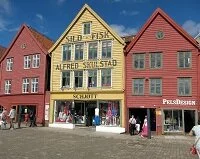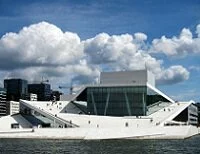 Bryggen
Bryggen in Bergen
Following in the trend of commercial growth, in the 1600s the cities of Kongsberg and Roros both arose as mining towns. Again houses and churches were present and remain among the most impressive structures in these towns, but the buildings again shifted in style as many of the most noticeable structures were built and used for mining operations and shipping, creating very specialized buildings.
Most architectural movements of mainland Europe never made their way to Norway or if they did, they did so with very limited influence. This began to change in 1814 when Norway gained greater freedoms as they separated from Denmark and shifted their capital under their new Swedish rulers. With a new capital city, new construction began and many buildings in historic Oslo were built in the popular styles of that time, most notably neo-Classical. This also began a time when new constructions were built, including a university, government buildings, and numerous commercial structures.

Oslo Opera House
In the 1900s Norway continued to adopt trends from Europe and today the city of Alesund has a huge number of Art Nouveau buildings, which were built after much of the city was burned down in 1904. Other large cities, such as Oslo also built in this style to a degree.
In the latter half of the 1900s and into the 2000s sky scrapers, modern architecture, and post-modern structures have been built throughout Norway. Oslo is home to much of the country's more recent architectural movements and this is perhaps best represented with the capital's post-modern Opera House (2007). However, for a cross section of all of Norway's architectural history, Bergen is probably the best example, while only a village can truly provide traditional wooden architecture as most of the country knows it, including the famed stave churches.